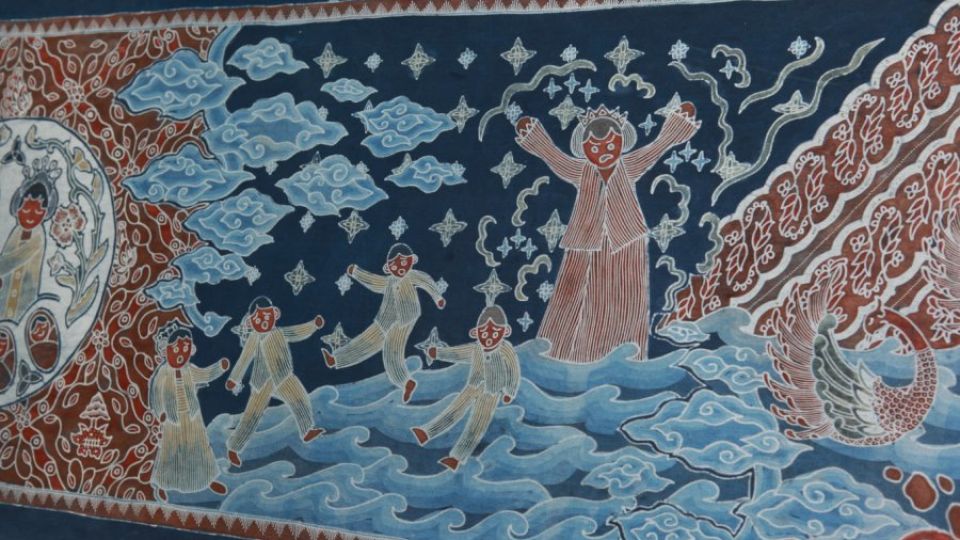March 13, 2025
JAKARTA – St Patrick’s Day, March 17, has long been a global phenomenon, with parades, revelry and traditional Irish music, but beyond special events in a few expat bars in South Jakarta and Bali, this is not a tradition that has ever made much of an impact on Indonesia.
And yet, what would happen if an artist set out to create a fusion of the spirit of Ireland with the vibrant traditions of Indonesia? After all, the two cultures share a deep appreciation for dance, myth and communal festivities. Would it be possible to blend the symbolism of two very individual cultural identities, separated by oceans and continents to create something entirely new but still deeply rooted in their respective traditions?
Textile and fashion designer Vania Gracia set out to achieve this while still studying at the Institute of Technology Bandung (ITB) in 2021. Vania already had a deep passion for batik and was studying how to create batik motifs in a program set up by ITB aimed at supporting the batik industry in Pangandaran, when she came across an Instagram post announcing a competition to create a batik motif that could be used by the Embassy of Ireland. With little knowledge of Ireland and largely out of curiosity she took part, researching Irish imagery and creating a motif based on that instantly recognizable symbol of Ireland, the shamrock.
On an emerald green background, the swirling trefoils intertwine amid the golden hues and floral motifs of traditional batik. The design was an instant winner and is now used by the embassy as a souvenir kain that can be made into shirts or simply worn as a skirt in whatever traditional Indonesian style the wearer prefers.
In 2023, Vania’s thesis focused on integrating batik with electronic textiles to make a fashion collection. Before graduating, the Irish Embassy reached out again, inviting her to design several more batik pieces. The embassy granted her full creative freedom, with only a time limit as a constraint. Vania began by researching Irish culture and she was immediately drawn to its rich folklore. As an Indonesian, she found a deep connection between Irish and Indonesian folk tales, both brimming with wonder, magic and cultural heritage. After extensive discussions with the embassy, they selected two sets of stories and legends, these were St. Brigid, St. Patrick and Queen Medb, followed by The Children of Lir, The Salmon of Knowledge and Cú Chulainn.
The concept behind these batik paintings was to narrate Irish folklore through the intricate language of batik. Each visual item and motif was carefully chosen to enhance the storytelling. Vania’s goal was to introduce Indonesians to Irish folklore while offering Ireland a fresh perspective on its own ancient stories. A unique detail in the artwork is that all the characters are depicted in traditional Indonesian clothing, a particular request by Irish Ambassador Pádraig Francis.
The batik paintings were created in collaboration with Batik Pohon and Ca Nur, with frames provided by Toko Hidayat, Bandung. The pieces were first exhibited at Orasis, Surabaya, before being displayed in “Irish Legends Through Indonesian Eyes”, an exhibition of batik art to mark the 40th anniversary of Indonesian-Irish diplomatic relations on June 3, 2024, in the lobby of World Trade Centre 2 in Central Jakarta. They were later displayed at the Textile Museum in Jakarta.
So impressed was it by her work that the Spanish Embassy offered Vania her next commission. She had the honor of designing the embassy’s first-ever batik piece, inspired by Spanish culture. Dominated by Spain’s iconic red and yellow, the design features national symbols such as the bull, rose, carnation, Sagrada Familia Basilica, a Spanish fan and guitar. The composition drew inspiration from both traditional batik patterns and the Manila Shawl. This Spanish batik was later turned into souvenirs by the embassy and printed on books and folders, further solidifying the fusion of Spanish heritage with Indonesian textile artistry.
In seamlessly blending the intricate elegance of Indonesian batik with the aesthetics of two very different Western European cultures, Vania has created a visual dialogue that transcends boundaries. Her work not only pays homage to the deep-rooted traditions of batik but also reimagines it in a contemporary global context, proving that heritage and modernity can coexist in harmony. This fusion of East and West is more than just a stylistic innovation, it is a testament to the power of art in bridging cultures, fostering appreciation and inspiring new creative possibilities.
Through her visionary approach, Vania Gracia has not only redefined batik but also opened doors for a richer, more interconnected world of Indonesian design.


